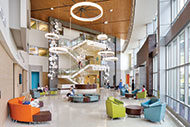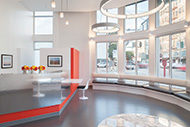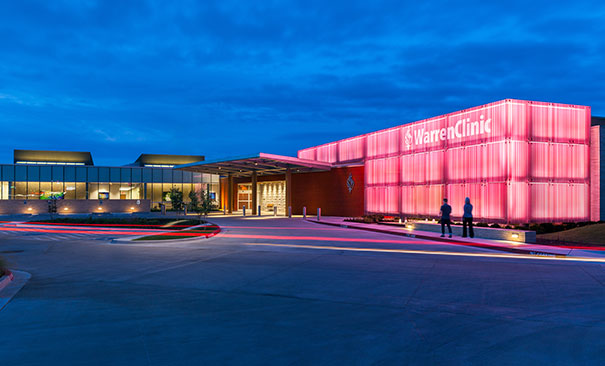
Saint Francis Health System's signature pink exterior at its flagship hospital is translated at its ambulatory care centers through a pink-lit exterior.
Over the past few years, the ongoing shift to provide more accessible health care services has led to an increase in new ambulatory care clinics. With an estimated 500,000-plus ambulatory care centers in the United States, this trend continues to gain momentum as health systems look for new avenues to help decrease care delivery costs. It also provides them with the opportunity to expand their brand and respond to increased demand.
Ambulatory care centers leading the pack know that the key to success combines design with community engagement. The goal is to keep patients engaged in their health, both acute and preventive, by creating an environment that provides a high level of care and becomes an integrated part of the community.
In Tulsa, Okla., the Warren Clinic is helping to define a new era of ambulatory care.
Warren Clinic is the employed physician arm of the Saint Francis Health System. To provide more patients in the Tulsa area with quality ambulatory care, Saint Francis opened three new Warren Clinic locations. The CallisonRTKL architectural team worked alongside Saint Francis to design and brand each clinic: South Memorial, Tulsa Hills and North Broken Arrow.
Each site provides urgent care, radiology, lab and clinical functions, primary care and specialty services. The new clinics range in size from 12,000 to 25,000 square feet. These new clinics stand out against competitors by creating patient-friendly, operationally efficient clinics that clearly reflect Saint Francis Health System's vision and mission of delivering high-quality health care to the region they serve.
Saint Francis Health System wanted to look at ways to implement an ambulatory strategy within the Warren Clinic. The system's three focus areas when designing and creating these clinics were to create a clinic around a module design, to create a prototype that they could easily adapt to multiple sites and, finally, to promote its brand. CallisonRTKL helped to incorporate solutions to these objectives into the design of the three new clinics.
The new Warren Clinic sites are examples of the ambulatory care trend that is evident in health care today.
Think pink
An important factor in designing ambulatory care centers is to combine the design with community engagement. Staying true to brand elements can set ambulatory centers apart from competitors and keep patients engaged.
Most companies have a unique identifier. The golden arches belong to McDonald's, while Nike wouldn't be the same without its signature "swoosh." To residents of Tulsa, Saint Francis Health System is known as the "pink" hospital thanks to the all-pink exterior of its flagship hospital.
To increase brand recognition, CallisonRTKL's design team incorporated this already established trademark when designing each of the new clinics. At the front exterior of each clinic, a glass wall infused with varying pink tones supports the pink theme. This feature wall creates a visual icon to the public and draws patients through the door. Upholding the pink theme in its clinics also reinforces its legacy and its connection to the community it serves.
Quality of Care
As an integrated part of the community, ambulatory care centers rely on returning patients. While brand recognition helps to bring patients through the door, the quality of care keeps them coming back. Delivering patient-focused, high-quality care with a pleasant experience was the main focus for the design. The clinics are a modular health prototype, providing the ability to adapt to multiple sites in various configurations.
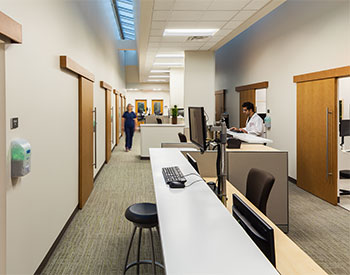
The Warren Clinics have a distinct separation between patient-facing and off-stage tasks.
Traditionally, a clinic is made up of a series of exam rooms around a central core, which contains the needed resources and materials to support those exam rooms, resulting in the intermixing of patients and visitors with staff and creating a great deal of traffic within the clinics. Therefore, Warren Clinic sought to turn the traditional clinic inside out, creating an "on-stage, off-stage" approach. This approach builds the exam rooms around "home team" pods where staff and physicians can collaborate together and work more efficiently. Patients are able to approach exam rooms from separate corridors, providing them with a quieter, more private waiting area. Patient flow is greatly improved, along with the elimination of cross-contamination between patients.
This on-stage, off-stage method was implemented by Walt Disney World into its operations to separate the staff's behind-the-scenes work from the customer experience. Similarly, a patient's experience in a clinic can be hindered by certain elements of a staff's behind-the-scenes work. This effective customer experience approach provides the patient with a more positive experience within the clinics.
Designing Excellence
Certain design elements were integrated into the clinics to provide patients and staff with a pleasant, welcoming environment. The concept of "Light from Above," was established by utilizing natural light as a primary driver for the interior design. Large windows and skylights line the hallways and patient exam room waiting areas to provide daylight. The modular prototype maximizes visual access to exterior gardens, as well as natural light for the public and staff, allowing every occupied room of the clinic access to daylight. Views to landscaping and water features, as well as South Memorial's view to a courtyard with gardens and a seating area, a pond with a water fountain, and an open field can be seen from the interior. These design elements provide patients and staff with a more enjoyable experience within the clinics.
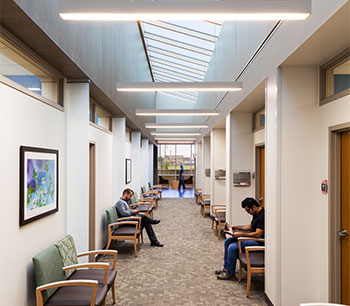
An abundance of light floods the waiting rooms and hallways of each clinic.
Maximizing Convenience
It's important to remember that ambulatory care centers are not hospitals, but they are proving to be one of the most successful ways for established brands to expand and increase their community presence. Flexibility, convenience and accessibility continue to be main drivers behind the rise of ambulatory care centers. These factors make outpatient care even more desirable. To enhance these factors, the new Warren Clinic locations were strategically placed on streets centrally located in areas with plenty of drive-by traffic. Because the sites are easily accessible from busy streets and are clearly visible, this adds additional convenience for patients and the public.
The creation of a branded, modular prototype reinforces Warren Clinic's mission of innovation and wellness while encompassing a sense of community. Implementing new care models makes for an easier, more convenient experience for the patient and creates a collaborative environment for the staff. In the end, these elements come together to improve community health outcomes.
John Seely is a senior vice president in CallisonRTKL's health care practice group. His 16-year career includes work on more than 3 million square feet of commercial facilities and 10 million square feet of health care projects.



